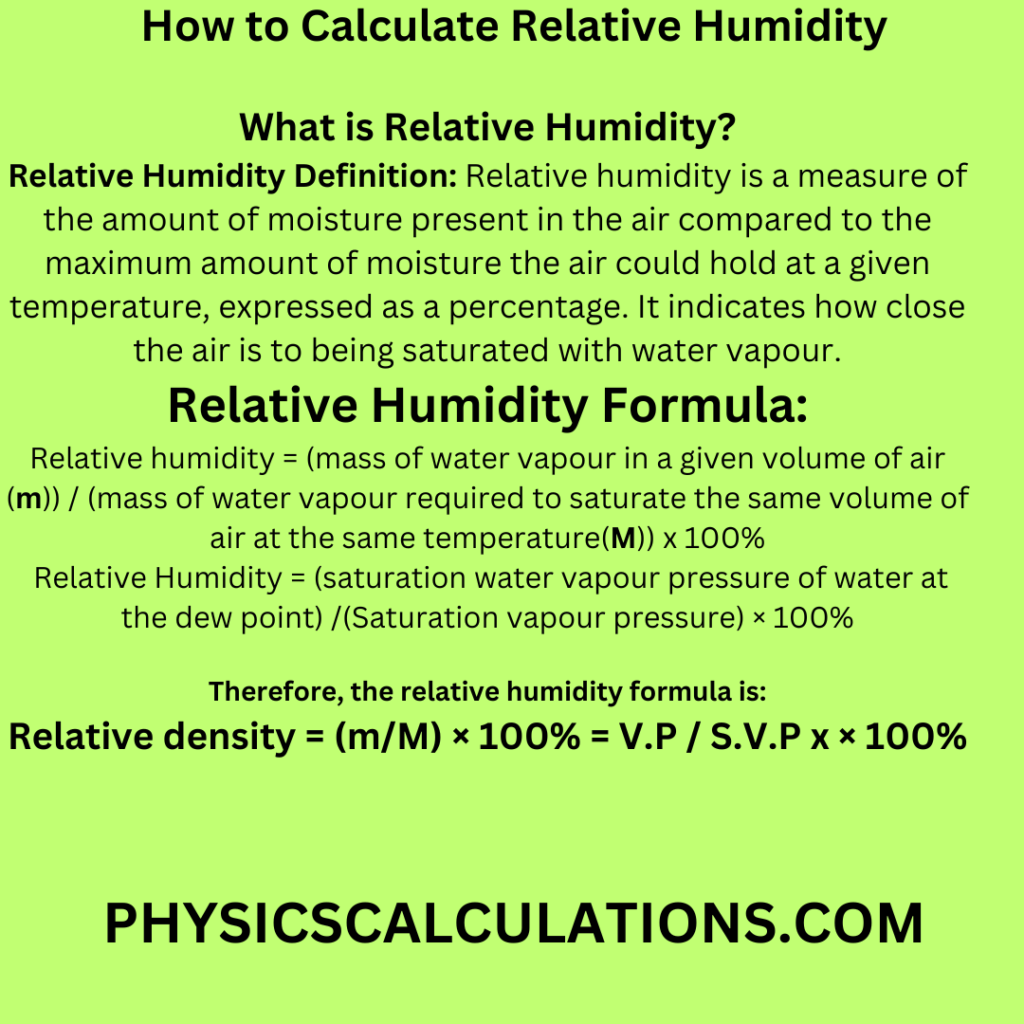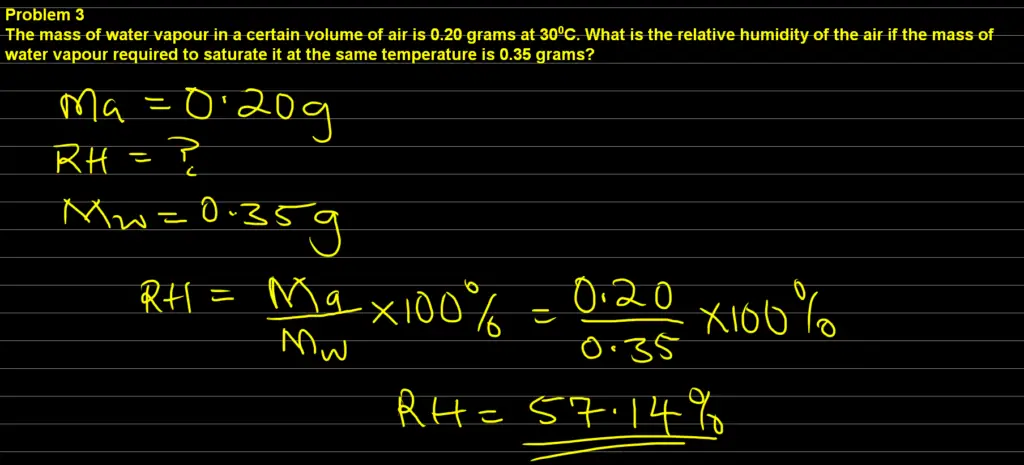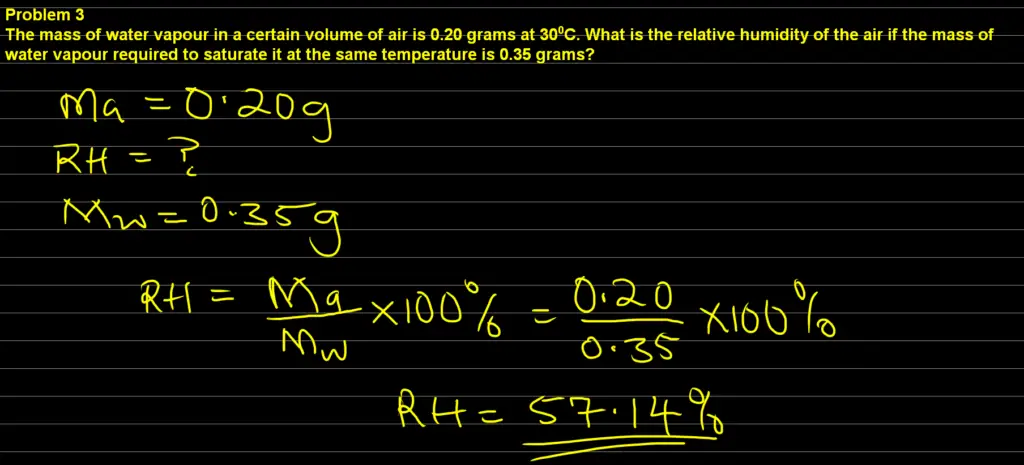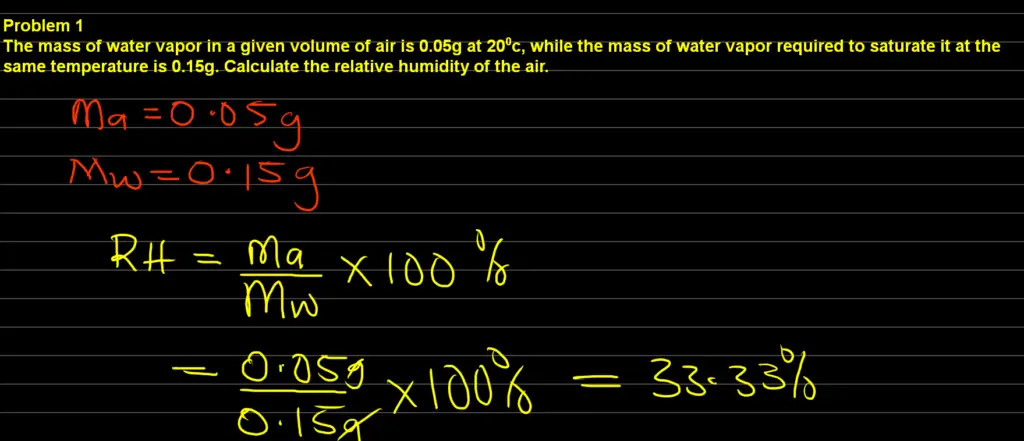What is Relative Humidity?
Relative Humidity Definition: Relative humidity is a measure of the amount of moisture present in the air compared to the maximum amount of moisture the air can hold at a given temperature, expressed as a percentage. It indicates how close the air is to being saturated with water vapour. In this article, you will learn how to calculate relative humidity using a formula.
Relative Humidity Formula
The relative humidity formula that we use for calculation are as follows:
First Formula: Relative Humidity (%) = (Actual Vapor Pressure / Saturation Vapor Pressure) × 100
Second Formula: Relative Humidity = [(Vapor pressure (partial pressure) of the air) / (Saturation vapour pressure at the temperature of the air)] × 100%.
Third Formula: Relative Humidity = (specific humidity/saturation vapor pressure) x 100%
Fourth Formula: Relative humidity = [(mass of water vapour in a given volume of air (m)) / (mass of water vapour required to saturate the same volume of air at the same temperature(M))] x 100%
Fifth Formula: Relative Humidity = [(saturation water vapour pressure of water at the dew point) /(Saturation vapour pressure)] × 100%
Therefore,
Relative density = (m/M) × 100% = V.P / S.V.P x × 100%
Where:
- Actual Vapor Pressure is the pressure exerted by water vapour in the air.
- Saturation Vapor Pressure is the maximum pressure water vapour can exert at a given temperature before condensation occurs.
The final answer for relative humidity is in percentage (%)
How to Calculate Relative Humidity
Relative humidity measures the amount of moisture present in the air compared to the maximum amount the air can hold at a given temperature.

It is often expressed as a percentage and is a fundamental concept in understanding weather patterns and comfort levels. There are two primary methods for calculating relative humidity
Using the Dew Point and Temperature
- Determine the Dew Point: Measure the current air temperature and use a dew point calculator or chart to find the dew point temperature. The dew point is the temperature at which air becomes saturated with moisture and condensation begins.
- Calculate the Vapor Pressure: Use the dew point temperature to calculate the vapor pressure of the air. This is the pressure exerted by water vapor in the air.
- Find the Saturation Vapor Pressure: Determine the saturation vapor pressure at the current air temperature using empirical equations or tables.
- Calculate Relative Humidity: Divide the vapor pressure by the saturation vapor pressure and multiply by 100 to get the relative humidity percentage.
Using Wet and Dry Bulb Temperatures
- Measure Wet and Dry Bulb Temperatures: Use a hygrometer to measure the wet bulb and dry bulb temperatures.
- Calculate Wet Bulb Depression: Find the difference between the dry bulb and wet bulb temperatures. This is known as the wet bulb depression.
- Determine Relative Humidity: Use a psychrometric chart or online calculator to find the relative humidity based on the wet bulb depression and the dry bulb temperature.
You may also like to check:
How to Calculate the Velocity Ratio of a screw Jack
Solved Problems: How to Calculate Relative Humidity
Here are a few examples of how to calculate relative humidity using a formula
Problem 1
The mass of water vapor in a given volume of air is 0.05g at 200c, while the mass of water vapor required to saturate it at the same temperature is 0.15g. Calculate the relative humidity of the air.

Solution
Data
Mass of water vapor in a given volume of air, Ma = 0.05g
Mass of water vapor required to saturate it at the same temperature, Mw = 0.15g
Relative humidity of air, Ra = ?
and
Ra = ( Ma / Mw ) x 100%
Ra = ( 0.05 / 0.15 ) x 100% = 33.33%
Problem 2
Assuming the actual vapor density is 20g/m3 at 300c compared to the saturation vapor density at the same temperature of 25g/m3. Calculate the relative humidity of the air.

Solution
Data:
Actual vapor density = 20g/m3
saturation vapor density = 25g/m3
Relative humidity = ?
And the formula is
Relative Humidity = (specific humidity/saturation vapor pressure) x 100%
Relative Humidity = (20/25) x 100% = 0.8 x 100% = 80%
Problem 3
The mass of water vapour in a certain volume of air is 0.20 grams at 300C. What is the relative humidity of the air if the mass of water vapour required to saturate it at the same temperature is 0.35 grams?
Final answer: The relative humidity of the air is 57.14%

Data: Information from the question
Mass of water vapour, m = 0.20 g
The mass of water vapour required for saturation, M = 0.35 g
Unknown: What we need to find
Relative humidity (R.H) = ?
Formula: The equation that will help us solve the problem
Relative humidity = (mass of water vapour in a given volume of air (m)) / (mass of water vapour required to saturate the same volume of air at the same temperature(M)) x 100%
Which can be written as Relative humidity = (m/M) x 100%
Solution
Substituting our formula with our data, we will have
Relative humidity = (m/M) x 100% = (0.2/0.35) x 100% = 57.14%
Problem 4
The table below shows the saturation vapour pressure against in a particular city. If on a certain day, the vapour pressure in this city at 300C is 22.0 mmHg, what is the relative humidity?
| T0C | 0 | 10 | 20 | 30 | 40 | 50 | 60 |
| S.V.P(mmHg) | 4.6 | 9.2 | 17.5 | 31.8 | 55.1 | 92.5 | 149.0 |
Solution
Vapour pressure at 300C, V.P = 22.0 mmHg
Saturated vapour pressure of air at 300C, S.V.P = 31.8 mmHg
Therefore, we will now apply the formula
Relative Humdity = (V.P) / (S.V.P) x 100% = (22.0 / 31.8) x 100% = 69.2%
Therefore, the relative humidity is 69.2%
Problem 5
On a certain day, the dew point is 100C when the temperature of the air is 320C. Calculate the relative humidity of the air .(S.V.P of water at 320C and 100C are 16.2mmHg and 9.8mmHg respectively).
Solution
S.V.P at dew point (100C) = 9.8 mmHg
Also, S.V.P at air temperature (320C) = 16.2 mmHg
Thus, Relative Humdity = (S.V.P at dew point / S.V.P at air temperature) x 100% = (9.8 / 16.2) x 100% = 60.5%
Therefore, the relative humidity of the air is 60.5%
Factors Affecting Relative Humidity
Several factors can influence relative humidity readings and impact its accuracy:
- Temperature: Higher temperatures can lower relative humidity readings even if the moisture content remains constant.
- Air Pressure: Changes in atmospheric pressure can affect the saturation vapor pressure and, consequently, the relative humidity.
- Altitude: Higher altitudes can lead to lower air pressure, affecting relative humidity calculations.
- Local Environment: Urban areas with increased human activity can have altered humidity levels due to factors like industrial processes and air conditioning.
Importance of Accurate Relative Humidity Measurements
Understanding and accurately calculating relative humidity is essential for various applications:
- Weather Forecasting: Meteorologists use relative humidity data to predict weather patterns and assess the likelihood of precipitation.
- Agriculture: Farmers use relative humidity readings to make informed decisions about irrigation and crop management.
- HVAC Systems: Maintaining optimal relative humidity levels is crucial for efficient HVAC system operation and indoor comfort.
- Health and Comfort: High humidity levels can lead to discomfort and health issues, while low humidity can cause dry skin and respiratory problems.
FAQs
Is relative humidity the same as humidity?
No, relative humidity and humidity are not the same. Humidity refers to the amount of water vapor in the air, while relative humidity compares the actual moisture content to the maximum amount the air could hold at a given temperature.
Can relative humidity be above 100%?
Yes, relative humidity can exceed 100% in certain conditions. This occurs when the air is supersaturated with moisture, and condensation begins to form.
What is the ideal relative humidity for indoor comfort?
For most indoor environments, a relative humidity range of 40% to 60% is considered optimal for human comfort and health.
How does relative humidity affect the perception of temperature?
Higher relative humidity levels can make temperatures feel hotter than they actually are due to reduced evaporative cooling from the skin.
Is relative humidity constant throughout the day?
No, relative humidity can vary throughout the day based on temperature changes and other environmental factors.
How does relative humidity impact the drying of materials?
Materials such as wood and paper can absorb or release moisture based on relative humidity levels, affecting their structural integrity.
You may also like to check:
Check:
Arewagist – Health and Nutrition
Wokminer – Apply for Job